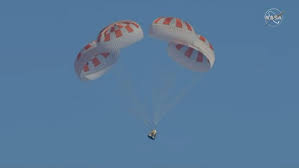Funnel in the snow
 Can a man slow down his fall? Yes, says Professor Bjornstig. If you fall flat, stretching your legs and arms as wide as possible, the top speed will be about 200 km / h, he explains. “If you reduce the resistance, for example, fall head first, you can accelerate to 420-430 km / h.”
Can a man slow down his fall? Yes, says Professor Bjornstig. If you fall flat, stretching your legs and arms as wide as possible, the top speed will be about 200 km / h, he explains. “If you reduce the resistance, for example, fall head first, you can accelerate to 420-430 km / h.”
For example, a skydiver will reduce the speed of fall to a minimum, but on what surface is he best to land?
In 2009, James Bull from Staffordshire fell from an altitude of 1830 meters. It happened in Russia. He crashed into deep snow, a crater formed from the blow, but the paratrooper survived.
In 2006, Michael Holmes, an experienced Jersey parachutist, was denied primary and backup parachutes, and he crashed from a height of 3.2 km. He was lucky to fall into the thick bushes of a blackberry.
Victoria Chilli fell on a plowed field near the airfield, having received fractures of the pelvis, ribs and cracks of several vertebrae. According to eyewitnesses, the surface of the arable land was unusually soft.
Professor Björnstig says that when a person has reached the limit of fall, he needs a cushioning layer in front of a hard surface — at least half a meter thick — to avoid fatal injuries. For example, snow, swamp or tree branches.
A paratrooper in distress needs to find such a “soft spot”. This is difficult, but it is possible that the American stuntman Luc Akins showed in July 2016.




